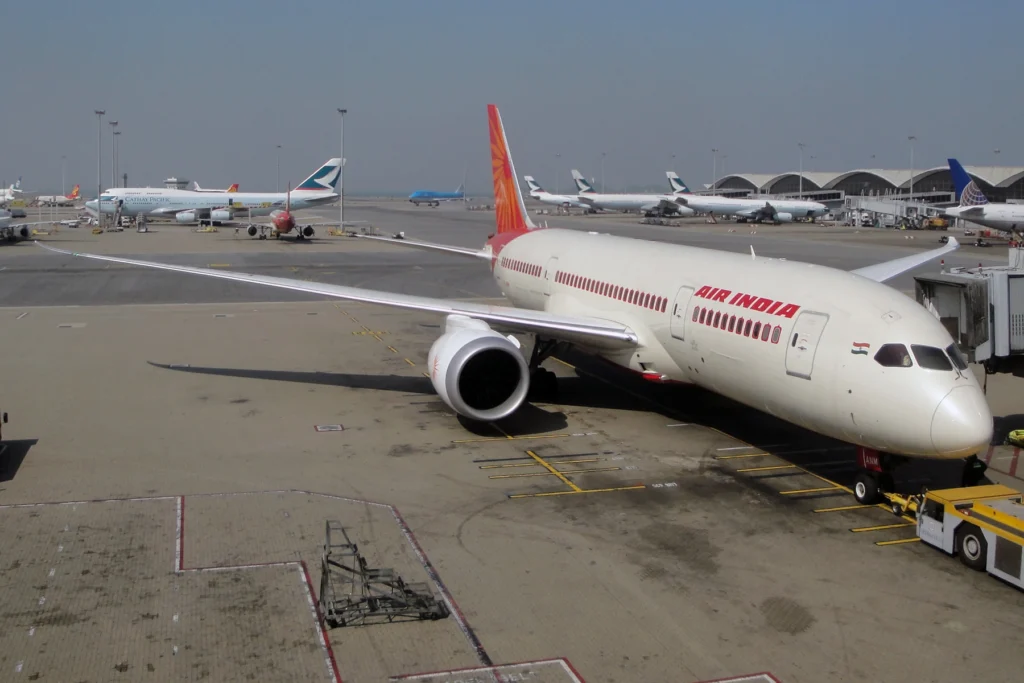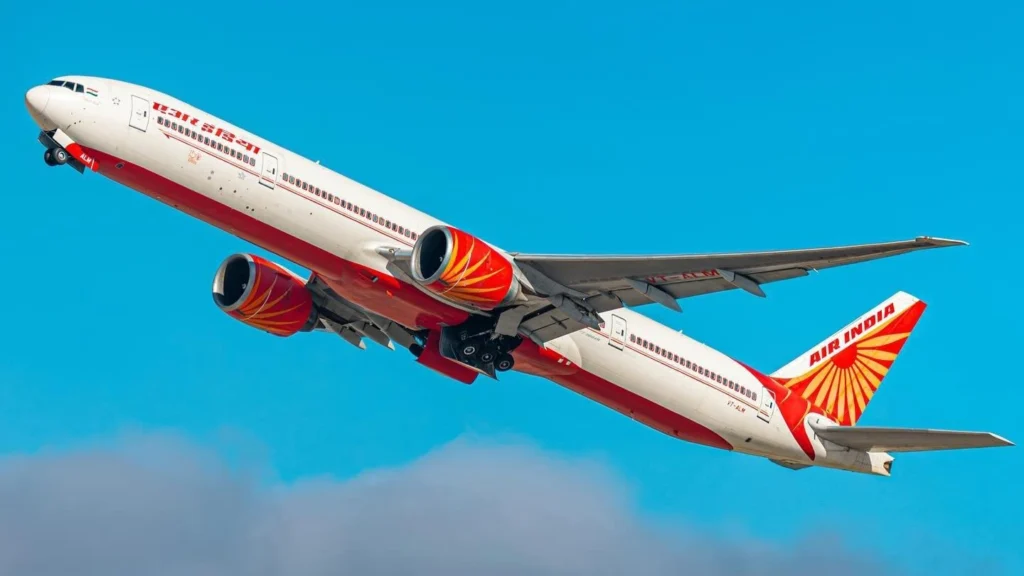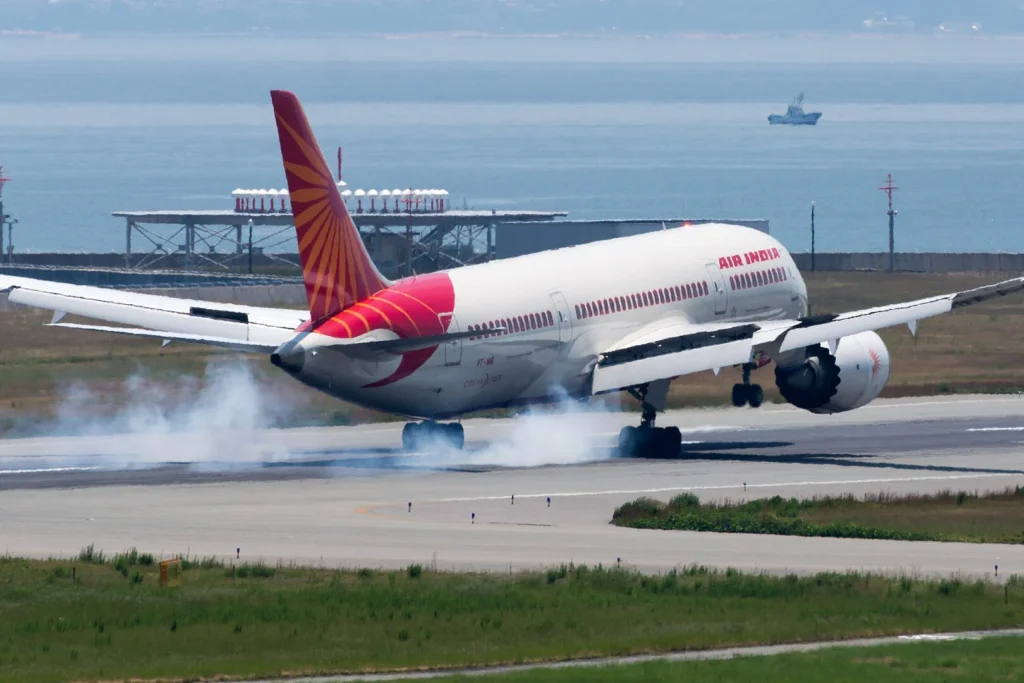VIENNA— A Tata-Group-owned Air India (AI) flight traveling from New Delhi (DEL) to Washington, DC (IAD) made a scheduled fuel stop in Vienna (VIE) but failed to continue its journey due to unexpected maintenance issues.
Flight AI103 departed New Delhi on July 2 and landed in Vienna as planned. However, the onward flight to Washington, DC was cancelled after technical checks flagged a maintenance requirement.

Air India Cancels Delhi to Washington Flight
According to Air India (AI), the refueling stop in Vienna (VIE) was scheduled for Flight AI103 en route to Washington Dulles International Airport (IAD).
During routine inspections at Vienna International Airport, engineers identified a maintenance issue that required immediate attention before the aircraft could proceed.
As a result, the airline cancelled the Vienna–Washington sector to prioritize safety. All passengers were disembarked and informed about the delay and cancellation.
The flight was operated by a 7.8-year-old Boeing 787-8 Dreamliner, registered as VT-NAC.
The disruption also affected the return leg, Flight AI104 from Washington, DC (IAD) to New Delhi (DEL), which was to operate via Vienna. With the aircraft grounded in Austria, Air India cancelled this flight as well.
Passengers booked on AI104 were either rebooked on alternate flights or offered a full refund, depending on individual preferences, the airline confirmed. The carrier reiterated its commitment to safety and customer service amid the operational setback.
Air India emphasized that the delay stemmed from adherence to strict safety protocols. Though the extended maintenance caused inconvenience, the airline cited the importance of resolving technical issues before resuming long-haul operations.

Similar Incident
An Air India (AI) flight from Delhi (DEL) to Vienna (VIE) dropped 900 feet shortly after takeoff, triggering stall and terrain warnings mid-air. The Boeing 777, operating as AI 187, landed safely, but both pilots have been grounded.
The Directorate General of Civil Aviation (DGCA) has launched a formal investigation into the June 14 incident, which comes amid heightened scrutiny following a fatal Air India crash in Ahmedabad (AMD) just two days earlier.
On June 14, 2025, Air India (AI) flight AI 187 departed from Indira Gandhi International Airport (DEL) at 2:56 AM en route to Vienna International Airport (VIE).
Minutes into the climb, the Boeing 777 experienced a sudden loss of nearly 900 feet in altitude. The onboard systems triggered multiple warnings, including a stall alert and the Ground Proximity Warning System (GPWS), which issued repeated “Don’t Sink” advisories.
Despite the severe warning signals, the flight crew managed to recover control of the aircraft and proceeded without further incident.
The nine-hour journey concluded safely in Vienna. Preliminary analysis of the flight data recorder (FDR) confirmed the significant altitude deviation and activation of safety systems, indicating a critical in-flight anomaly.
Air India immediately reported the event to the DGCA in compliance with regulatory protocols. The airline confirmed that both pilots involved have been removed from active duty pending a comprehensive inquiry.
The DGCA has summoned Air India’s Head of Safety to examine possible lapses related to maintenance procedures, crew response protocols, and broader operational safety systems. Authorities are particularly focused on whether human error or technical issues contributed to the near-stall event.
This investigation coincides with growing concern over Air India’s safety record, especially in light of the tragic crash of AI 171 in Ahmedabad (AMD) on June 12, which claimed over 260 lives.

Some 787 Grounded
Air India is grappling with a major operational challenge. At least nine of its Boeing 787-8 Dreamliner aircraft, critical to long-haul operations, remain grounded as of July 2025.
This includes multiple jets parked at key airports like Kolkata (CCU) and Delhi (DEL), placing pressure on the airline’s global expansion plans and route reliability. The situation complicates efforts to modernize its fleet and restore competitiveness against global rivals like Emirates (EK), Qatar Airways (QR), and Singapore Airlines (SQ).
The Boeing 787-8 Dreamliner forms the core of Air India’s medium- and long-haul fleet. However, nine Dreamliners are currently listed as non-operational due to a combination of technical issues, scheduled overhauls, or long-term storage. These aircraft include:
- VT-ANI – AOG at Kolkata (CCU)
- VT-ANJ – AOG at Delhi (DEL)
- VT-ANM – AOG, location undisclosed
- VT-ANN, VT-ANO, VT-ANR, VT-ANW, VT-TSD – All inactive with no recent commercial activity
The grounding significantly restricts scheduling flexibility at a time when Air India is actively restoring and expanding international routes. The airline has yet to release an official statement detailing the cause or expected timeline for these aircraft to return to service.
Industry analysts suggest a mix of maintenance backlogs, shortage of replacement parts, and deferred upgrades are contributing to the delays. With international travel rebounding and demand rising, the airline’s inability to fully deploy its wide-body fleet could hinder its global recovery ambitions.
The grounded aircraft reduce overall fleet utilization and strain operational capacity, especially during peak international travel periods. This adds complexity to the carrier’s goal of becoming a serious contender on competitive international corridors, particularly those to Europe, North America, and Southeast Asia.
Among the inactive wide-body aircraft is a notable outlier: VT-ALL, a Boeing 777-300ER grounded at Nagpur (NAG) since February 23, 2024. The 17.6-year-old jet, nicknamed Goa, has reportedly been cannibalized for spare parts during the pandemic and is unlikely to return to service.
The VT-ALL was used as a donor aircraft to support operational jets amid COVID-related supply disruptions. No maintenance work or revival plan has been announced, suggesting the aircraft may be permanently retired.
Stay tuned with us. Further, follow us on social media for the latest updates.
Join us on Telegram Group for the Latest Aviation Updates. Subsequently, follow us on Google News

